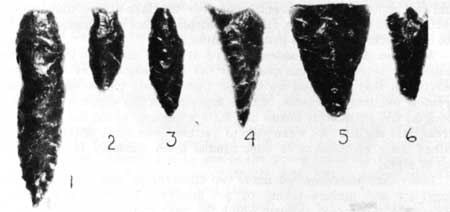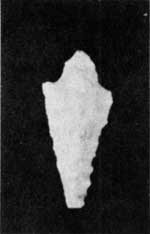|
Volume XVIII - 1952

Fig. 1
Indian Relics On Mt. Mazama
By Richard M. Brown, Ranger-Naturalist

Fig. 2
|
On August 11, 1952 an arrowhead (Fig. 2) was brought to the
Information Building by a visitor who had found it that morning at the
viewpoint near Discovery Point, not far from the plaque which calls
attention to glacial scratches on rock at the Rim. It is quite possible
that this arrowhead was exposed by the heavy thundershowers which
occurred during a four-day period shortly before the day on which it was
found. This becomes the seventh Indian point in the park collection,
earlier finds having been made in Godfrey Glen (Fig. 1, Nos. 1,2,3)
along the first turn in the highway leaving the Rim Village (Fig. 1, No.
4) and on the upper part of the Garfield Peak Trail (Fig. 1, Nos. 5,6).
The unique feature of this arrowhead is that it has been made from
opaque whitish-colored rock, whereas all of the others are of are of
translucent obsidian.
The Indians which once lived in this region are known to have been
superstitious of Crater Lake and Mt. Mazama, considering the area to be
the home and battleground of the gods. For this reason they established
their camps a considerable distance away from the mountain and seldom
ventured near this sacred abode. One of their legends, however, provides
some clear evidence they occasionally hunted in the forests on the
slopes of Mt. Mazama itself (Homuth, 1929). Our growing collection of
Indian points contributes significantly to the belief that this and
other Indian legends concerning Mt. Mazama may contain considerable
basis in fact.
Reference
Homuth, Earl U. 1929. An Indian Legend. Nature Notes from Crater
Lake, 2(3):2-3.
The Northern Mountain Lizard
By Robert C. Wood, Ranger-Naturalist
The small lizard, Sceloporus graciosus gracilis Baird and
Girard, often called "mountain swift", because of its ability to move so
rapidly, is not at all common in Crater Lake National Park. It is
usually found in dry, fairly open areas where there are logs or old
stumps in which it seeks cover when disturbed. Because these lizards are
so elusive there are many more recorded observations than there are
specimens in the Park collection.
Until this year, the northern mountain lizard had been recorded in
only three localities within the Park. These were Wheeler Creek Canyon,
the Rim above the Palisades, and the east side of Annie Creek in the
Park panhandle. The only specimens from the Park had been taken at
Wheeler Creek Canyon in 1948 by D. G. Findlay and D. S. Farner.
Individuals had also been observed just outside the south boundary in
the dry brushy country east of Annie Creek and it was there that Dr. D.
S. Farner collected a specimen in 1948.
During the summer of 1952, several new observations were made and a
specimen was collected which furthered our knowledge of the distribution
of this lizard both within and adjacent to the Park. On July 29
Ranger-Naturalists Ralph Welles, Richard M. Brown, and the writer saw
several individuals along the fire motorway east of Annie Creek near the
south boundary but were unable to capture them. Ranger-Naturalists Brown
and I returned to the area on August 4 and managed to secure two
specimens. One was caught just outside the Park boundary, the other
barely inside it. They were both obtained by Brown, using a snare on a
fishpole.
The other record of this Sceloporus was obtained by Dr.
Albert P. Blair and Arthur Barclay on August 6. They observed two
northern mountain lizards at the Wineglass about 40 feet up from the
lake. Both Richard Brown and the writer searched unsuccessfully for them
several days later.
The Sedentary Habits Of Canada Jays
By Dorothy C. Farner and Donald S. Farner, Assistant Park Naturalist
It has long been suspected that individual Canada Jays,
Perisareus canadensis (Linnaeus) are normally restricted
throughout their lives to a relatively small area (Farner, 1952:76). Of
course such a hypothesis can be definitely confirmed only by the
observation of marked individuals. Results thus far obtained from the
banding of Canada Jays in Crater Lake National Park strongly support the
hypothesis although more data are needed to understand fully the degree
of restriction of movement among these birds.
Canada Jays have been banded at Park Headquarters and at Annie
Spring. Most of them have been marked with the numbered aluminum bands
of the U.S. Fish and Wildlife Service and with colored aluminum bands
supplied by the Massachusetts Audubon Society. Using two- and three-band
combinations, always with at least one numbered aluminum band, it has
been possible to give each bird a distinctive combination allowing
identification without recapture.
Twenty-seven banded Canada Jays have been observed at least once
after banding. Of these, ten were not seen after the season of banding.
Of the remaining seventeen one was recorded nine years after banding;
two, four years after banding; three, three years; two, two years; and
nine, one year after banding. At least nine of the seventeen are known
to be alive at the time of this writing.
In seeking banded Canada Jays we vigorously inspect three areas: the
Rim Village and Rim Campground, Annie Spring Campground, and Park
Headquarters. In the course of field work in other parts of the Park all
Canada Jays encountered are carefully examined with field glasses for
bands.
It is quite amazing to note that with only one exception all
twenty-seven birds, involving more than a hundred observations,
invariably have been observed within 200 yards of the banding site. The
single exception (Farner, 1947:31) was a bird banded by W. T. Frost at
Annie Spring on December 27, 1937, and recovered on August 6, 1947,
about one mile from the banding locality.
It is of interest to contrast our experience with Canada Jays and
our experience with Clark's Nutcracker, Nucifraga columbiana
(Wilson). Nutcrackers have been banded at Rim Village, Park
Headquarters, and Annie Spring. It is by no means an uncommon experience
to find Nutcrackers banded at one station appearing at the other two,
either in the same or different seasons. In two cases we found evidence
of almost daily movements between Annie Spring and the Rim Village. We
also have observed banded Nutcrackers along the West side of the Rim
several miles from the banding site at the Rim Village. This experience
with Nutcrackers is cited primarily as evidence to indicate that were
there similar movement by Canada Jays, we would have detected them.
Although more data are needed in order to be conclusive, there is
certainly every reason to believe that the Canada Jays of this area are
extremely sedentary.
References
Farner, Dorothy C. 1951. Banding Crows and Jays. Crater Lake
Nature Notes, 17:12-15.
Farner, Donald S. 1947. An interesting recovery of a banded Gray
Jay. Bird-Banding, 18(1):31-32.
Farner, Donald S. 1952. The Birds of Crater Lake National
Park. University of Kansas Press. ix + 200 pp.
| 
